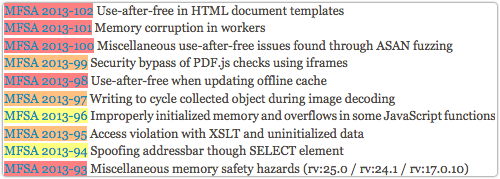New RSA Products and Services Boost Security Operations; Eliminate Security And Compliance Trade-Offs
AMSTERDAM, Oct. 29, 2013 /PRNewswire/ — RSA CONFERENCE EUROPE 2013
New Summary:
— New products and services help organizations build and advance their
security operations functions while expanded visibility provides the
ability to respond to incidents quicker and reduce the business impact.
— Enhanced RSA Security Analytics solution addresses SIEM and compliance
requirements while complimenting a longer-term advanced security
operations strategy.
— The new RSA Security Operations Management solution enables enterprises
to seamlessly orchestrate people, process and technology to effectively
detect and respond to security incidents.
— RSA continues to help close the industry skills gap with new RSA
Advanced Cyber Defense (ACD) incident response retainer and industry
education service.
Full Story:
RSA, The Security Division of EMC (NYSE: EMC), today announced a new combination of products and services to help organizations mature their security operations and accelerate incident response functions while addressing traditional SIEM requirements as part of a advanced security strategy.
Read more about this news at EMC’s product and technology blog, EMC Pulse here.
The offerings include a significant update to RSA Security Analytics, a new RSA Security Operations Management solution and new RSA Advanced Cyber Defense (ACD) services – RSA Retainer for Incident Response and RSA START for Incident Handling – along with new analyst-focused education modules. The combined offerings are designed to empower organizations to continuously and consistently improve management of their security incident lifecycle – from detection, to investigation, to response and learning/process improvement.
Updates to the RSA Security Analytics solution provide additional deployment options for customers to speed adoption and advance security initiatives.
Featuring a new, modular architecture, RSA Security Analytics helps address key SIEM and logging requirements while reducing costs for long-term data retention.
Combining SIEM with near real-time streaming analytics helps expedite incident detection and alerting while an enhanced interface incorporates visualization capabilities to help improve identification of suspicious events.
Additionally, the new RSA Security Operations Management software and RSA ACD services create a unique interoperable incident response solution with focused consultancy and education services to help customers continually improve their Security Operations over time. They include:
RSA Security Operations Management – New solution enables robust orchestration of intelligence, context, processes and resources, thereby:
— Centralizing incident management and integrating business context
— Offering best practice incident management recommendations that leverage
industry-standard frameworks, as well as RSA-developed best practices
— Providing a breach impact analysis framework and recommended breach
response procedures
— Enabling SOC managers to manage the entire IT security team and measure
the effectiveness of their incident response teams.
RSA ACD Response and Learning Services
— RSA Retainer for Incident Response provides an experienced RSA response
team on retainer to help organizations respond to critical incidents.
— RSA START for Incident Handling provides forensic assessment services to
help organizations proactively improve incident response procedures.
— New SOC/CIRC analyst-focused education modules help increase the skills
of security analysts in detecting, analyzing and responding to security
incidents.
RSA’s new offerings are designed not only to address the everyday challenges of today’s security teams, but also to enable organizations to quickly identify, respond and fully manage a crisis while, while helping them to build out mature security capabilities over time.
Analyst Quote:
Jon Oltsik, Senior Principal Analyst, Enterprise Strategy Group
“Even though organizations find themselves at varying levels of maturity when it comes to advanced security operations, it’s important they employ solutions that are able to grow along with their needs. Integrated solutions that comprise incident detection, investigation, and response, can help organizations reduce the overall impact of security incidents on the business, meet compliance requirements, and streamline security operations.”
RSA Executive Quote:
Grant Geyer, Vice President, RSA Security Analytics
“By offering a robust set of tools and resources for incident detection and response, RSA is helping organizations advance their current capabilities, and is also providing a solid blueprint and flexible platform to more easily build and mature a Security Operation Center to address the threats of tomorrow.”
Additional Resources:
— Learn more about RSA Security Analytics
— Learn more about RSA Security Operations
— Register for the upcoming Webcast: Prioritize Threats with Business
Context
— Learn more about RSA Advanced Cyber Defense Services
— EMC Pulse Blog: Dispatch From RSA Conference 2013: Improving Security
Operations Management, While Moving SIEM Forward With Advanced Analytics
— Connect with EMC via Twitter, Facebook, YouTube, LinkedIn and ECN About RSA
RSA, The Security Division of EMC, is the premier provider of intelligence-driven security solutions. RSA helps the world’s leading organizations solve their most complex and sensitive security challenges:
managing organizational risk, safeguarding mobile access and collaboration, preventing online fraud, and defending against advanced threats.
Combining agile controls for identity assurance, fraud detection, and data protection, robust Security Analytics and industry-leading GRC capabilities, and expert consulting and advisory services, RSA brings visibility and trust to millions of user identities, the data they create, the transactions they perform, and the IT infrastructure they rely on. For more information, please visit www.EMC.com/RSA.
RSA and EMC are either registered trademarks or trademarks of EMC Corporation in the United States and/or other countries. All other company and product names may be trademarks of their respective owners.
Article source: http://www.darkreading.com/management/new-rsa-products-and-services-boost-secu/240163336



